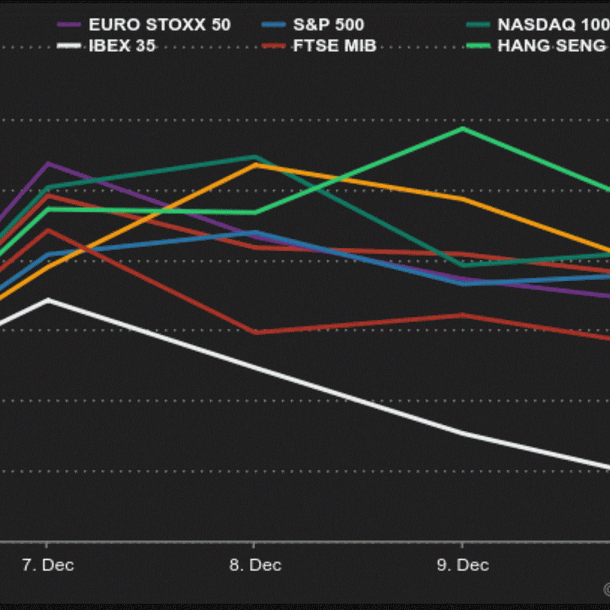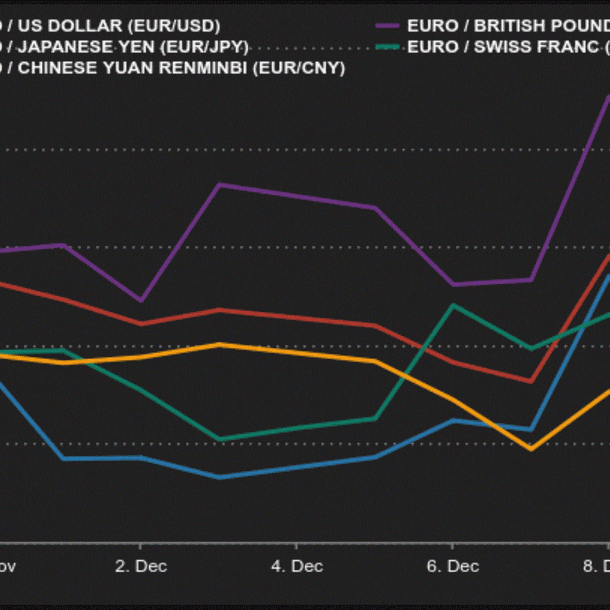|
Friday December 10 | Weekly market update |
 |
After two weeks of sharp decline cause by the discovery of the new Omicron variant, financial markets have recovered in recent sessions, reassured by reports of milder symptoms and the effectiveness of vaccine boosters. Risk appetite has abruptly resurfaced, allowing some indexes to return close to their November records. Volatility could persist in the weeks to come, depending on new announcements on the health front, but also because of several central bank decisions next week. |
| Indexes Over the last five days, in Asia, the Shanghai Composite has recovered 1.6%, the Nikkei 1.5% and the Hang Seng 1%. In Europe, despite some declines in recent days, weekly performances remain significant. The CAC40 gained 3.3%, the Dax 3.0% and the Footsie 2.4%. In the peripheral countries, Italy gained 3%, Spain 1.4% and Portugal 1.3%. In the US the S&P500 rebounded by 3.3%, the Dow Jones gained 3.6% and the Nasdaq100 3.1%, despite expectations of an acceleration of tapering due to persistent inflationary pressures.  |
| Commodities Like equities, volatility remained high on oil markets, which are under pressure due to concerns over the Omicron variant but also over the default of the two Chinese developers Evergrande and Kaisa. Despite this, oil prices are expected to end the week higher, with traders preferring to see the glass as half-full regarding the rising oil consumption for 2022. The North Sea benchmark is thus recovering at USD 74.7 per barrel while WTI is trading around USD 71.4. Increased volatility in risky assets, inflationary pressures, negative real yields of major bonds, nothing seems to be able to embellish gold prices. The barbarian relic is trading around the USD 1,800 mark, precisely at USD 1,770 per ounce. Silver is following the same infernal dynamic, falling below USD 22. On the industrial metals front, copper and nickel stabilized at USD 9580 and USD 20,000 respectively, while lead and tin registered a positive weekly performance at USD 2330 and USD 40,000 per ton. A word on agricultural commodities with lumber, whose price has risen back above USD 1,000 due to flooding in British Columbia which is disrupting Canadian exports to the United States. |
| Equity markets Lucid (-24%): the week started badly and ended just as badly for the electric vehicle manufacturer. Since Thursday, it is the announcement of a dilutive financing via convertible bonds that is not going well. Earlier in the week, the company revealed that the SEC had asked for information about its IPO via the SPAC Churchill Capital Corp IV. The US regulator seems determined to clean up the SPAC craze in the US. Marvell Technology (+26.7%) reports better-than-expected results. The chipmaker, which managed to circumvent supply issues, reports quarterly revenue up 61% to $1.2 billion. The outlook is good. Smartsheet (+18.3%) the enterprise collaboration software company, reaches new records. Quarterly revenues are up 46%, and new subscriptions are soaring, which led the company to raise its outlook. Docusign (36.1%) disappoints. The electronic signature specialist did better than expected in the last quarter, with $545 million in revenue, but unveiled timid forecasts for the next. |
| Macroeconomics The week was relatively quiet on the macroeconomic indicator front, at least until Friday, when US inflation for November was released. In Germany, the ZEW German Financial Confidence Index for November exceeded expectations, while inflation was confirmed up 6% year-over-year. In the United States, consumer prices rose by 0.8% last month, compared to an expected 0.7%. This is a slightly slower pace than in October. Over a year, inflation reached 6.8%, and 4.9% excluding the most volatile elements. The initial reaction of markets was positive, perhaps because an upward slide would have definitely forced the Fed to accelerate its monetary tightening program. On the currency front, the Turkish lira continued to decline against the euro and the dollar, but to a lesser extent than the previous week. The euro/dollar fell back below 1.13 during the week. On the major pairs, the variations remain narrow. Sovereign rates moved a bit during the week, without moving much from their recent levels. Over 10 years, the US T-Bond yields 1.48%, the German Bund -0.36% and the French OAT -0.01%. Regarding crypto-currencies, the market as a whole has suffered a consequent drop of more than 12% in a week, and bitcoin itself cannot boast of better resistance by posting a similar drop at the time of writing. Black Saturday, December 3, saw $2.5 billion worth of liquidations on the bitcoin futures market, which partly explains the episodic fall in the price to around $42,000 on that day, only to fall back to just under $50,000 today. A nervous end to the year in the digital asset market. The macroeconomic agenda is particularly dense this week. That's why we're devoting a large part of this column to it. If we had to pick just one event, it would be the US central bank's last monetary policy decision of 2021, scheduled for Wednesday December 15. Will the Fed stick to the path of support reduction it has set out to curb inflation, or will it put the pedal to the metal to incorporate the latest health threats? That is the question. The next day, the ECB will have to decide. The week will also be marked by the publication of the Flash manufacturing and services PMIs for December, which will give a good indication of the economic dynamics of the major economies for the end of the year.  |
| Rocket-flation for the end of the year While inflation is accelerating at a record pace in November, the Omicron variant seems to have had less impact on markets this week. Players were reassured by Pfizer's announcements, which seemed to confirm the efficiency of booster jabs. All eyes are on the West, where the FED could accelerate the end of its asset purchases. Next week will mark the announcement by central banks of their decisions on key rates, with the FED on Wednesday and the ECB on Thursday. |

 By
By 
















